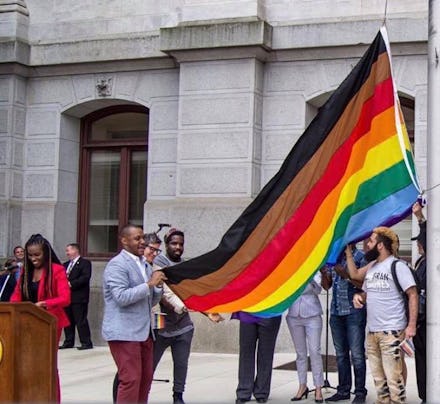Philadelphia's black and brown pride flag stirred huge controversy. That's good, advocates say.

Wednesday was Flag Day, a national holiday that commemorated the adoption of America's star-spangled national symbol. But another flag dominated online conversation: Philadelphia's new LGBTQ pride flag, which included two new stripes, one black and one brown, to highlight people of color in the LGBTQ community.
The flag's mere existence caused extreme outrage on all corners of social media and led to multiple contentious comment threads on Facebook and Twitter.
Among some of the most popular arguments against the flag were that it perverted the original intent of the flag's creator, Gilbert Baker, who they say never meant for the flag to be about race. Others called the flag "racist" for highlighting black and brown people in the community.
But, according to Amber Hikes, executive director of Philadelphia's Office of LGBT Affairs and a black queer woman, seeing the flag without the crucial Philadelphia context is to miss the whole story.
"This is a local initiative; it’s a local response," Hikes said in a phone interview. "We did not anticipate this becoming a national conversation."
That local context involves two years of intense controversy around allegations of racism in the city's Gayborhood. In January, the city released a report about racism among the neighborhood's bars and nonprofits, the result of more than a year of protests over discriminatory dress codes and a video in which a local gay bar owner used racial slurs to disparage black patrons.
And as for accusations that Philadelphia's local flag competes with Gilbert Baker's, Hikes made it clear this flag "is not instead of, it’s in addition to."
"I love the rainbow flag, it's a beautiful flag," Hikes said. "But having additional flags in our community don't make the original flag null and void."
Hikes pointed to the litany of flags that exist to celebrate parts of the community rather than subsume Baker's original design. She specifically mentioned the bisexual, transgender, bear and leather pride flags.
"I'm inspired by a symbol, while stable and static, that is able to change with its community," she said.
According to Abdul-Aliy Muhammad, co-founder of Philadelphia's Black and Brown Workers Collective, the flag is proof that the racism that "entrenched racism and anti-blackness" persists in LGBTQ spaces, a point activists in Philadelphia have been trying to make in the last two years.
"The fact that two stripes have triggered the online and offline responses that it has, it just proves that there is entrenched racism and anti-blackness [in the community]," Muhammad said. "This is real, this is lived and this is felt by us on a daily basis."
Though Hikes did not expect the local conversation to become national, she is happy that people are discussing racism in the LGBTQ community.
"During the HIV/AIDs crisis, we said that silence is death, and not having these conversations will not get us anywhere," she said. "Conversation is essential to our growth as a community."
The flag, Hikes said, is not an end-all-be-all, but rather a symbolic promise that substantive measures addressing racism in Philadelphia will be coming out of her office.
"My office will be producing symbolic and substantive measures," Hikes said. "This is one of the symbolic measures to represent the substantive measures that will be following."